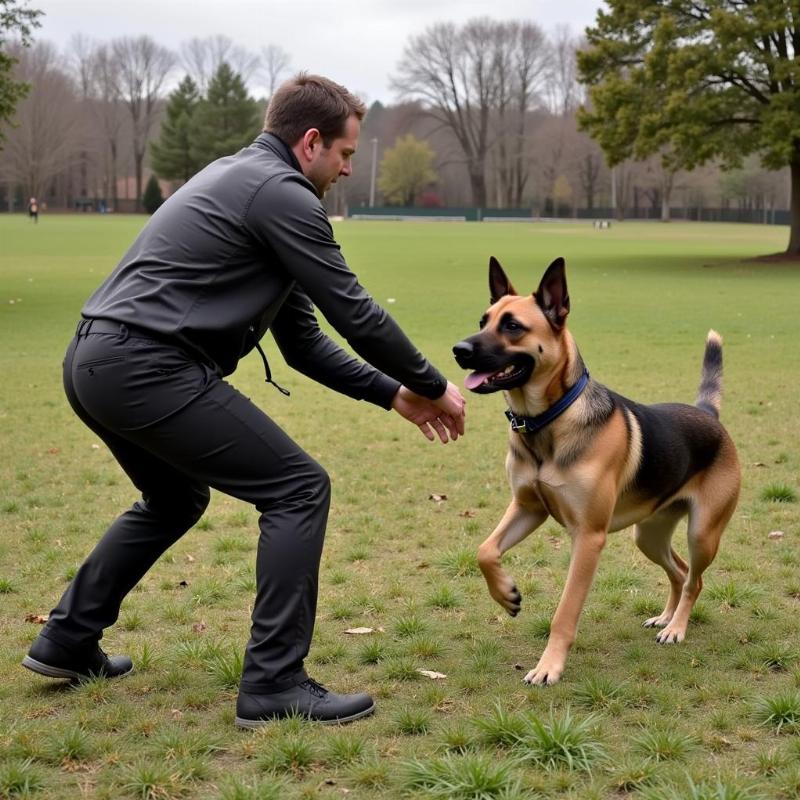Protecting their family is a deeply ingrained instinct in many dogs, but it’s not a guarantee with every breed or individual. Understanding your dog’s behavior and temperament can give you clues about their protective potential. This article delves into the signs that indicate whether your dog might protect you in a threatening situation, while emphasizing responsible pet ownership and realistic expectations. We’ll explore breed tendencies, individual personality traits, and how proper training can influence a dog’s protective instincts.
Recognizing Protective Instincts in Your Dog
While some breeds are naturally more predisposed to protective behaviors, it’s crucial to remember that each dog is an individual. Even within protective breeds, individual temperament varies greatly. Look for these signs that might suggest your dog has protective tendencies:
- Alertness: A protective dog is usually highly aware of their surroundings, constantly scanning for potential threats. They may bark at strangers approaching your home or car.
- Territoriality: They might display territorial behaviors like patrolling your property, barking at passersby, or guarding their favorite spots.
- Body Language Cues: In a perceived threat, a protective dog may stand between you and the perceived danger, stiffen their body, raise their hackles, and give a low growl.
- Protective Barking: This is different from regular barking. It’s usually deeper, more insistent, and directed towards the perceived threat.
- Shadowing: A protective dog might follow you closely, especially if they sense you’re uneasy or in a potentially dangerous situation.
Breed Specific Protective Traits
Certain breeds are known for their protective instincts. German Shepherds, Rottweilers, Doberman Pinschers, and Akitas are often chosen for their guarding abilities. However, it’s crucial to understand that responsible breeding practices and proper socialization are key to ensuring these dogs’ protective instincts are channeled appropriately. A poorly socialized dog of a protective breed can become overly aggressive, posing a danger rather than offering protection.
Understanding Your Dog’s Individual Personality
While breed can provide a general guideline, individual personality plays a much larger role. Even within the same litter, some puppies may be more naturally protective than others. Early socialization is crucial in shaping a dog’s temperament. Exposing your puppy to a variety of people, places, and situations helps them develop into well-adjusted adults who can distinguish between genuine threats and everyday occurrences.
The Role of Training in Protective Behavior
Training can enhance or modify a dog’s natural protective instincts. Obedience training is fundamental for any dog, especially those with protective tendencies. A well-trained dog will respond to your commands, even in stressful situations. Specialized protection training can be considered for dogs with strong protective instincts, but this should only be done under the guidance of a certified professional trainer.
 Chó bảo vệ được huấn luyện
Chó bảo vệ được huấn luyện
Can Any Dog Be Trained to Protect?
While any dog might display some level of protective behavior, not all dogs are suitable for formal protection training. Trying to force a non-protective dog into a guarding role can create anxiety and lead to unpredictable behaviors. It’s essential to respect your dog’s natural temperament and focus on building a strong bond based on trust and mutual respect.
Conclusion
Determining if your dog will protect you involves observing their behavior, understanding their breed tendencies, and recognizing the influence of training. While some dogs are naturally more protective, proper socialization and training are crucial for channeling these instincts responsibly. Remember, building a strong, loving relationship with your dog is the best foundation for a safe and fulfilling companionship. Focus on nurturing that bond, and you’ll have a loyal companion by your side, regardless of their protective capabilities.
FAQ
- How can I tell if my dog is being protective or aggressive? Protective behavior is usually directed towards a perceived threat and aimed at keeping you safe, while aggression is often unprovoked and can be directed towards anyone.
- Is it safe to encourage protective behavior in my dog? It depends on the dog’s temperament and your ability to provide consistent training and socialization. Consult with a professional trainer before attempting any protection training.
- My dog barks at everyone who comes to the door. Is this protective behavior? It could be territoriality, fear, or excitement. Observe your dog’s body language to determine the underlying emotion.
- What should I do if my dog displays overly aggressive behavior? Consult with a certified professional dog trainer or behaviorist immediately.
- Can a small dog be protective? Yes, even small dogs can be protective, although their physical limitations might make them less effective guardians.
- Do all guard dog breeds need protection training? No, not all guard dog breeds automatically need protection training. Focus on obedience training and socialization first.
- Is it cruel to train a dog for protection work? Not necessarily, as long as the training is done ethically and humanely by a qualified professional.
Related Articles
can i cook corn dogs in the air fryer
how long to cook corn dogs in the air fryer
About Beautdogs.us
Beautdogs.us is your premier online resource for all things dog-related in the USA. We offer expert advice on dog breeds, care, training, and product recommendations. Whether you’re a seasoned dog owner or just starting out, Beautdogs.us provides comprehensive and reliable information to help you navigate the world of dog ownership. Contact us for more information: Email: [email protected], Phone: +1 501-555-7529.